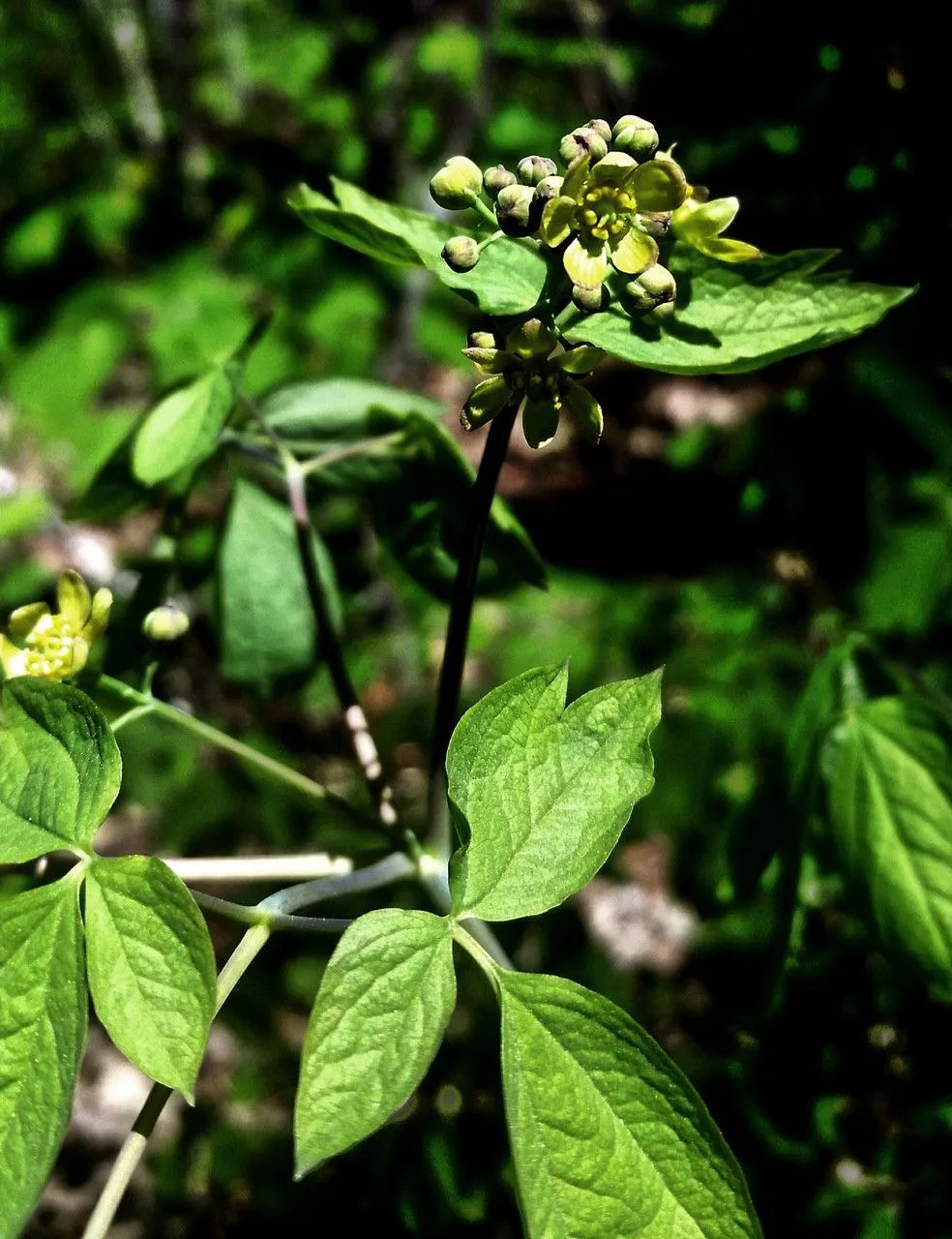
Author: (L.) Michx.
Bibliography: Fl. Bor.-Amer. 1: 205 (1803)
Year: 1803
Status: accepted
Rank: species
Genus: Caulophyllum
Vegetable: Unknown
Observations: C. & E. Canada to NC. & E. U.S.A.
Papooseroot, scientifically known as Caulophyllum thalictroides, is a perennial herbaceous plant that belongs to the Berberidaceae family. This fascinating plant can be found gracing the woodlands and shady habitats from central and eastern Canada, extending southward to North Carolina and the eastern United States.
The plant exhibits a unique charm with its distinctive morphology. Papooseroot typically grows to a height of approximately 30 to 60 centimeters and is characterized by its bluish-green leaves that are compound, divided into smaller leaflets resembling those of meadow rue, which it is sometimes mistaken for due to this resemblance. The leaves are supported by slender, sturdy stems that emerge from a thick, knobby rhizome.
Come spring, Papooseroot produces small, inconspicuous flowers that are yellow-green in hue. These blossoms cluster together in loose racemes and give way to deep blue, berry-like seeds by late summer to early fall. Interestingly, the flowers of Caulophyllum thalictroides are typically among the first to bloom in the forest understory, signaling the arrival of spring.
Ethnobotanically, Papooseroot has garnered attention for its historical medicinal uses. Native American tribes and early settlers have utilized it for a variety of purposes, particularly focusing on its roots. These roots were traditionally prepared as a tea or decoction to support women’s health, specifically for childbirth and to alleviate menstrual discomfort, hence its common name “Papooseroot.”
Papooseroot’s enduring presence across diverse geographical regions and its deep-rooted historical significance underscore the ecological and cultural tapestry of North American flora. As a native plant, it plays a vital role in the ecosystem, contributing to the biodiversity and health of the woodland environment.
Documented extensively in botanical literature, such as in the work titled “Fl. Bor.-Amer. 1: 205” published in 1803 by Michx, Caulophyllum thalictroides continues to intrigue botanists and plant enthusiasts alike. Through both academic and horticultural lenses, Papooseroot stands as a testament to the richness of North America’s botanical heritage.
Eng: blue cohosh, caulophylle faux-pigamon, papoose-root, papooseroot, squaw-root, squawroot
Swe: azurbär
Fra: caulophylle faux-pigamon, cohosh bleu, léontice faux-pigamon
En: Papooseroot, Squawroot, Blue cohosh, Caulophylle faux-pigamon, Papoose-root, Squaw-root
Fi: Amerikansinisiemen
Fr: Caulophylle faux-pigamon, Cohosh bleu, Léontice faux-pigamon
Hu: Kék indiángyökér
Sv: Azurbär
Taken Aug 20, 2022 by Joanna Lumbsden (cc-by-sa)
Taken Apr 18, 2021 by John Baglieri (cc-by-sa)
© copyright of the Board of Trustees of the Royal Botanic Gardens, Kew.
Taken Apr 20, 2022 by Beatriz Bicalho (cc-by-sa)
Taken Jun 27, 2021 by Justin Wood (cc-by-sa)
Taken May 14, 2022 by Pieter Verbrugghe (cc-by-sa)
Taken Apr 22, 2022 by David Botcherby (cc-by-sa)
Taken May 30, 2021 by Pro Monica (cc-by-sa)
Taken Aug 28, 2022 by Priscilla MV (cc-by-sa)
Taken Aug 25, 2020 by Julia H (cc-by-sa)
Taken Sep 8, 2019 by kristina (cc-by-sa)
Taken Sep 24, 2020 by Bernard Joyal (cc-by-sa)
Taken Oct 9, 2021 by Justine Oldenberg (cc-by-sa)
Taken Apr 24, 2022 by Jamie Carmichael (cc-by-sa)
Taken Apr 18, 2021 by wein gottz (cc-by-sa)
Taken Apr 27, 2022 by b jacoboose (cc-by-sa)
Taken May 6, 2013 by EOL − Dan Nydick (cc-by-nc)
Taken Apr 7, 2020 by Kyleigh Sadler (cc-by-sa)
Taken May 27, 2015 by EOL − Aarongunnar (cc-by-nc)
Taken May 10, 2015 by EOL − Charlie Hohn (cc-by-nc)
Taken Sep 10, 2015 by EOL − MJ Bach (cc-by-nc)
Taken Aug 19, 2015 by EOL − Mark Nenadov (cc-by-nc)
Taken Aug 24, 2015 by EOL − Ann Walter-Fromson (cc-by-nc)
Family: Myrtaceae Author: (F.Muell.) K.D.Hill & L.A.S.Johnson Bibliography: Telopea 6: 402 (1995) Year: 1995 Status:…
Family: Rubiaceae Author: Pierre ex A.Froehner Bibliography: Notizbl. Bot. Gart. Berlin-Dahlem 1: 237 (1897) Year:…
Family: Sapindaceae Author: Koidz. Bibliography: J. Coll. Sci. Imp. Univ. Tokyo 32(1): 38 (1911) Year:…
Family: Asteraceae Author: A.Gray Bibliography: Pacif. Railr. Rep.: 107 (1857) Year: 1857 Status: accepted Rank:…
Family: Fabaceae Author: Medik. Bibliography: Vorles. Churpfälz. Phys.-Ökon. Ges. 2: 398 (1787) Year: 1787 Status:…
Family: Aspleniaceae Author: (Cav.) Alston Bibliography: Bull. Misc. Inform. Kew 1932: 309 (1932) Year: 1932…